
Many thought that once the railway age had got under way, most canals would be considered anachronistic and ideas for new canal construction would be placed back on the shelf. But a new demand appeared thanks to another development in steam. The early steamships were, like the sailing ships, built of wood, which limited their size. However, Brunel had demonstrated that steam could be used successfully on Atlantic crossings – and that large ships were more economical than small vessels. He developed the iron ship driven by a propeller, the SS Great Britain. It ushered in a new age of large vessels and opened up new routes for steamers. But even the biggest ships had a problem on long voyages: stopping to refuel, so anything that could shorten distances was welcome. One busy route took ships between Europe and Asia and involved the long journey round the tip of Africa at Cape Horn. The obvious answer was a shortcut, through the narrow strip of land that separated the Red Sea from the Mediterranean. It was not a new idea.
As mentioned in Chapter 1, the first such canal had begun under the pharaohs, but had fallen into disuse. The canal built by Darius was restored some three centuries later by Ptolemy II in the third century BC, abandoned again and rebuilt once more by the Romans under Trajan (98–117 AD). Once again it was abandoned and once again restored by Amro Ibn Elass in the seventh century AD, partly for shipping grain and also to help devout Muslims reach the Holy Land. It was closed a century later to prevent a threatened invasion of Egypt. After these stops and starts, the project was abandoned for a thousand years.
The idea of a canal was resurrected when Napoleon invaded Egypt. He saw a possible canal as frustrating the British by giving the French better access to Asian markets. Work got under way under the engineer Charles Le Père, but he seriously overestimated the difference in levels between the two seas. His calculations showed the Red Sea as being a massive 10m higher than the Mediterranean and warned that the canal would have a devastating effect in draining water from the one to the other. So, yet another attempt at permanently creating the link failed, but not for long.
In 1833 a French group known as the Saint-Simonians, followers of the teachings of the Comte de Saint-Simon, who argued for a world based on industrialisation and scientific advance, arrived in Egypt. They looked again at the canal idea, but had not made much progress when plague hit Cairo. Several of the group died and the rest hurried back to France. They had, however, discussed their ideas with a young consular official, Ferdinand de Lesseps, and he in turn had talked it over with his friend Sa’id Pasha, the son of the Turkish Viceroy, Muhammad Ali. Nothing was done immediately, but the notion stayed with de Lesseps, even though he was posted away from Egypt in 1839.
The Saint-Simonians had also kept their ideas alive. In 1846 they formed an Association to carry out a formal study of the possibility of building the canal. A new engineering survey showed that the huge difference in levels between the two ends that had caused the abandonment of the Napoleonic proposal simply did not exist. There was no longer any sound engineering reason for not going ahead, but there were political objections. The British raised objections and Muhammad Ali showed little enthusiasm for the project. So once again everything came to a standstill. But a political change then revived it. In 1854 de Lesseps returned to Egypt as Consul where his old friend Sa’id Pasha was the new Viceroy. There was finally momentum and in 1858 La Compagnie Universelle du Canal Maritime du Suez was formed with authority to build the canal and run it for 99 years, after which ownership would revert to the Egyptian government. de Lesseps was given overall control.

Dredgers on the Suez Canal. Construction work began by cutting, often through hard rock, by hand. Once a sufficient depth had been excavated, water could be introduced and the dredgers floated in to deepen the channel. Material is being dug up from the bottom and the spoil is then being transferred to the bank via the long arm.
Earlier ship canals such as the Göta and the Caledonian had been built on modest lines, never intended for anything bigger than sailing ships. There was never any intention of making the Suez Canal available to sail, simply because the prevailing winds blew in just one direction for most of the year. This would be a canal for steamers, which would be reflected in the size of the operation. It was decided to make the canal one way, with a few passing places, but even so according to the original estimates more than two and a half million cubic metres of material would have to be removed, two million of that by dredging. Fortunately this was an age when new technologies made the task easier than it would have been for a previous generation of engineers.
Large steam-powered bucket dredgers were available as well as a new device, the suction dredger invented by Henri Bazin. A rotating harrow was lowered beneath the bows. This was used to loosen the material on the bed. Water jets mixed the material into a semi-liquid form so that as the vessel moved forward, it could be sucked up by tubes in the stern. It was claimed that the dredger could remove as much as 3,000 cubic metres a day from depths down to 8m to 12m. The dredgers were adapted for the different types of material met in building the canal. For soft rock, steel claws replaced the harrow used for dredging sandy material. Harder rock was broken up by rams with chisel pointed ends. These were monstrous machines: one had ten pointed rams, each 42ft long and weighing 4 tonnes. They were lifted by hydraulic power and allowed to drop onto the rock from heights of up to 20ft, at a rate of more than 200 blows an hour. There were five to each side of the dredger’s well and the debris was removed by a bucket dredger, operated by a four-cylinder steam engine. Some of the dredgers had chutes that reached to the shore to carry away the waste. The longest stretched for 60m, and was given extra support by means of posts resting on a barge.
In spite of all this high-tech equipment, there was still an immense workforce needed. Here, employment was little different from the slave labour used by the pharaohs. It was based on the corvée, a system of forced labour. It was thought that tens of thousands were brought in every month, but the death toll was horrific.
The canal itself is lock free, running from Port Said on the Mediterranean to Suez to the Red Sea and uses natural features along the way, notably the Great Bitter Lake. It could take the biggest vessels then afloat, with a depth of 8m, although it has subsequently been enlarged several times. The canal itself is 164km long and it reduced the distance for a journey from Britain to India by 7,000km.
The opening of the canal in 1868 was very grand, with convoys of ships setting off from either end, meeting in the middle at the bypass. The ceremony was attended by heads of state and dignitaries and all seemed set for a prosperous future. But the huge debts run up during construction, when the actual costs were double the original estimates, put a severe financial strain on the operation. The Egyptian government that held more than 40 per cent of the shares sold them to the British government in 1875. The story of the Suez Canal is as much about political wranglings as about engineering problems, a state of affairs that existed well into the second half of the twentieth century. Today it belongs to Egypt, where the authorities finished a major new development in 2015 that involved completing 35km of new canal and dredging another 37km to allow larger vessels to use the waterway. After so many stops and starts over the years, it is good news that one scheme at least was completed with no real troubles: in fact, although scheduled to take three years it was finished in just one – a rare accomplishment for any major engineering project.
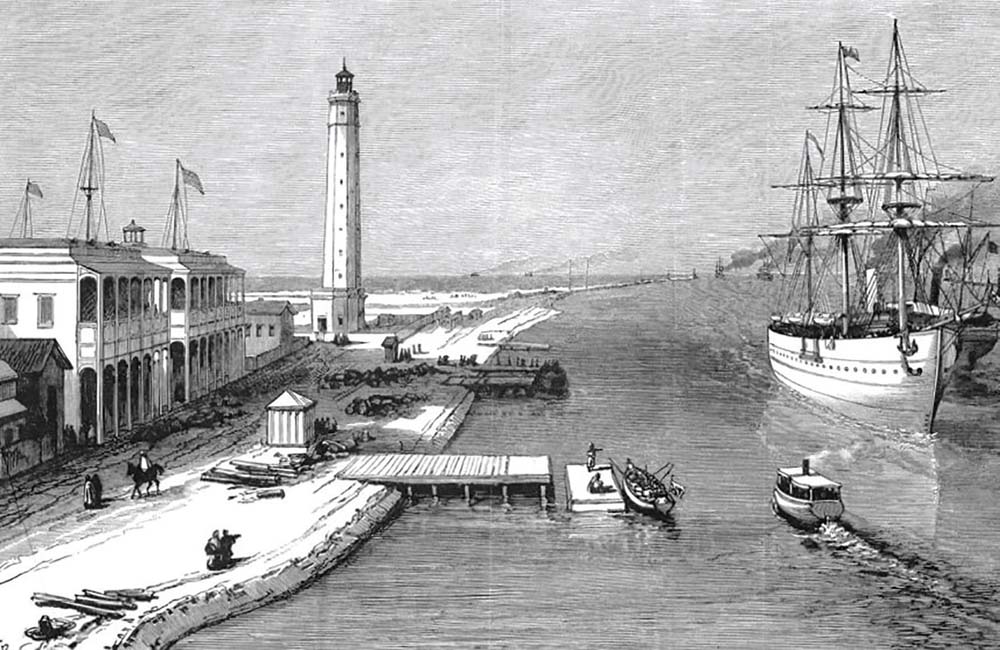
The Suez Canal at Port Said shortly after its opening in 1869. Much has changed over the years, but the prominent tower of the old lighthouse has survived.
Although nominally in charge of the Suez project, de Lesseps was no engineer. His role was largely political, reconciling the parties and countries involved and ensuring there was enough money to finish the works. But to most Frenchmen he was the Man of Suez, so when a scheme was put forward for another ship canal through the Isthmus of Panama, the narrow neck of land joining North and South America, he seemed the obvious choice for the job. An international congress was held in Paris in 1879 and two years later work began with de Lesseps in charge. He was then 76 years old and he was helped by his son Charles. The plan was for a lock-free canal like that at Suez, even though it would have to be cut through the rocky spine of the country, which at its highest point was 110m above sea level.
The scheme proved disastrous almost from the start. A huge workforce was recruited largely from the West Indies, but they suffered from disease, mostly malaria and yellow fever. Such fatal conditions were the result of infestation by insects, but no one knew which insects nor how to deal with them. The one ‘preventive’ measure taken was to stand the feet of beds in tins full of water to prevent insects crawling up. They could not have done anything worse. We now know that the problem was not crawling insects but mosquitoes, and the stagnant water under the beds proved the perfect breeding ground. The well-intentioned authorities had made matters worse and there was an appalling loss of life. An estimated 17,000 Caribbean workers died and some 5,000 French workers. Many engineers supervising the work died too, and others simply decided that life on the canal was too dangerous and headed back to France.
Even without the grim death toll, the work could hardly have gone forward. The decision to build a sea-level canal was always flawed. de Lesseps may have thought it was obvious that he could duplicate the success of Suez, but there is a big difference between constructing a waterway through the flat sands of a desert and building it through rocky hills and jungle. He had convinced the congress set up to review the proposals to accept his plans, largely because of the 136 delegates only 42 were engineers. There was also the difficult question of what should be done about the Chagres River that was likely, if left unchecked, to flood the canal in the rainy season.The scheme was essentially doomed.
Construction finally got under way at the beginning of 1881 with a labour force of some 40,000 men. It struggled on until 1887, when de Lesseps finally admitted that the original plan would not work, and they would have to build locks. The change was made, but it was too late. By 1889 some 900 million francs had been spent, slightly more than the original estimate for the whole project, and only two fifths of the work had been done. The company was bankrupt. It was a national scandal and there were strong indications of corruption. Opponents of the French government then in power demanded that someone’s head should roll. The scapegoat was de Lesseps. He was charged with mismanagement, but his son took full responsibility to save his aged father from imprisonment. Charles was found guilty and served a year in prison. A new company was set up to salvage something for the investors, but the best they could do was to bring in a small workforce to ensure that what had been completed did not deteriorate. The favourite solution was to find a buyer for the enterprise that was offered at 430 million francs ($109 million). America was the only likely purchaser, but apart from baulking at the price tag, some American engineers had other ideas about where and how the canal should be built.
What followed was an intense political struggle. There was a strong movement in America for making a canal, spurred on by an event in the Spanish-American war. The US had a naval base in Cuba, but when one of their battleships there was attacked and sunk in 1898, the only other battleship available was stationed in San Francisco and it took 72 days for it to complete the voyage round Cape Horn. With a canal, the trip would have taken a fraction of the time. However, a powerful faction favoured the canal project, but with a wholly new route through Nicaragua. Others wanted a route through Panama, then part of Colombia. Among those in favour of the latter was the distinguished civil engineer George Shattuck Morison, but oddly one of the decisive factors in persuading the US Senate to vote for the Panama route was a postage stamp. Each of the Senators was sent a Nicaraguan stamp showing a local volcano erupting: not the best advert for a spot in which to build a canal. Having agreed the route, all they then had to do was get permission from the Colombian government. They refused.
President Theodore Roosevelt, an enthusiastic supporter of the scheme, was infuriated. He lent his support – and a threatening American military presence – to the movement for Panama’s independence. Panama duly appeared as a new state in 1903, and had little option other than to grant the US sovereignty over a 10-mile strip of their new country, the Canal Zone. America paid the French for the work they had done and the equipment left behind. The French venture may have ended in failure, but they had excavated some 60 million cubic metres, of which 14 million was from the deep Culebra Cut. The Americans valued everything at $40 million, less than half the original asking price, and the French had little choice. It was that or nothing.
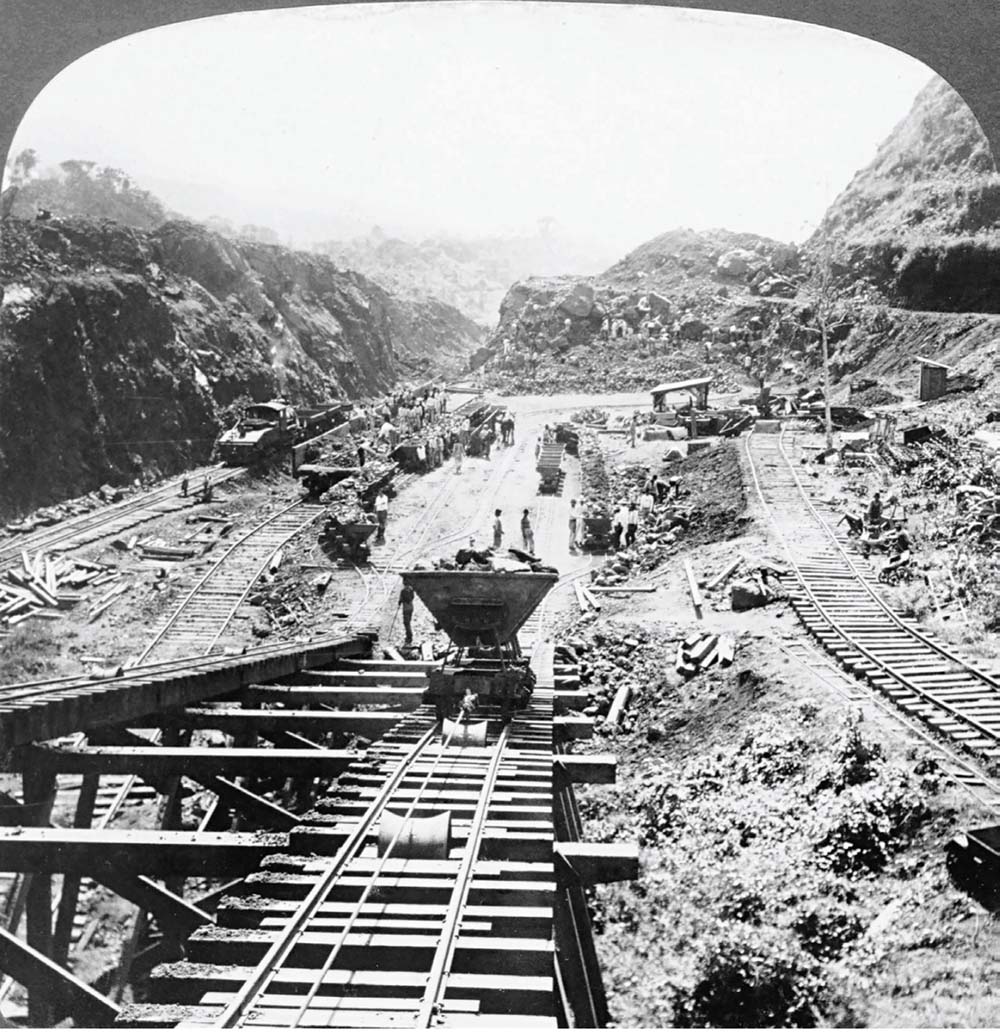
The photograph gives an excellent idea of the scale of operations during the building of the Panama Canal. As the excavations advanced through the rocky terrain of the Culebra Cut, they were followed by rail tracks at three levels, linked by inclined planes, allowing the spoil to be removed quickly and efficiently. (Library of Congress)
The Americans began work in 1904. Among the first to arrive on the scene were the medical team. Research had shown that mosquitoes carried the diseases, and the Chief Sanitary Officer, Dr William Gorgas, set about dealing with the problem. The yellow fever vector was comparatively easy to eradicate, but the malarial mosquito proved more resistant. It was described as being like ‘fighting the beasts of the jungle’. Methods used included draining swamps, introducing species that fed on the larvae of the mosquitoes and spraying poisons around the areas where the mosquitoes bred. There were still deaths from malaria but fatalities were measured in hundreds rather than thousands. This helped persuade Caribbean workers that it was now safe to work in the area and also protected essential skilled staff.
Building the canal was an immense operation in which railways played a key role, together with an array of mechanical excavators. The French had built a rail line that the chief engineer, John F. Stevens, realised was inadequate. The country was unable to provide the necessary food, housing and facilities for the huge workforce, so everything had to be imported and moved along the line of the canal by rail. The same railway had to supply equipment to the workings and carry away the spoil. To make this system more efficient, subsidiary lines were built at different levels within the cuttings. All equipment from rails to locomotives was brought in by sea and American railway workers had to both assemble everything themselves and then run the railway. When work got under way on the deep Culebra cutting that ran through the continental divide, there were some 6,000 men at work drilling holes into the rock and packing them with dynamite. So much material was removed that at times as many as 160 spoil trains a day were running from the site.
The Panama Canal involved work on a scale never attempted before. The French plans had been ambitious, but the Americans found them inadequate. Once the decision had been taken to build locks it was decided to make them even bigger than originally designed. There were to be three sets of locks, built in pairs, set side by side. There was a two-lock flight at Miraflores, followed by a single pair at Pedro Miguel, raising the canal from the Pacific to Gotun Lake, and the Gotun locks then lowered the canal down to the Atlantic. Each lock was 1,050ft long and 110ft wide. Where locks on earlier canals had been built from brick or stone, these locks were concrete. Their construction represents one of the greatest civil engineering feats of the time.
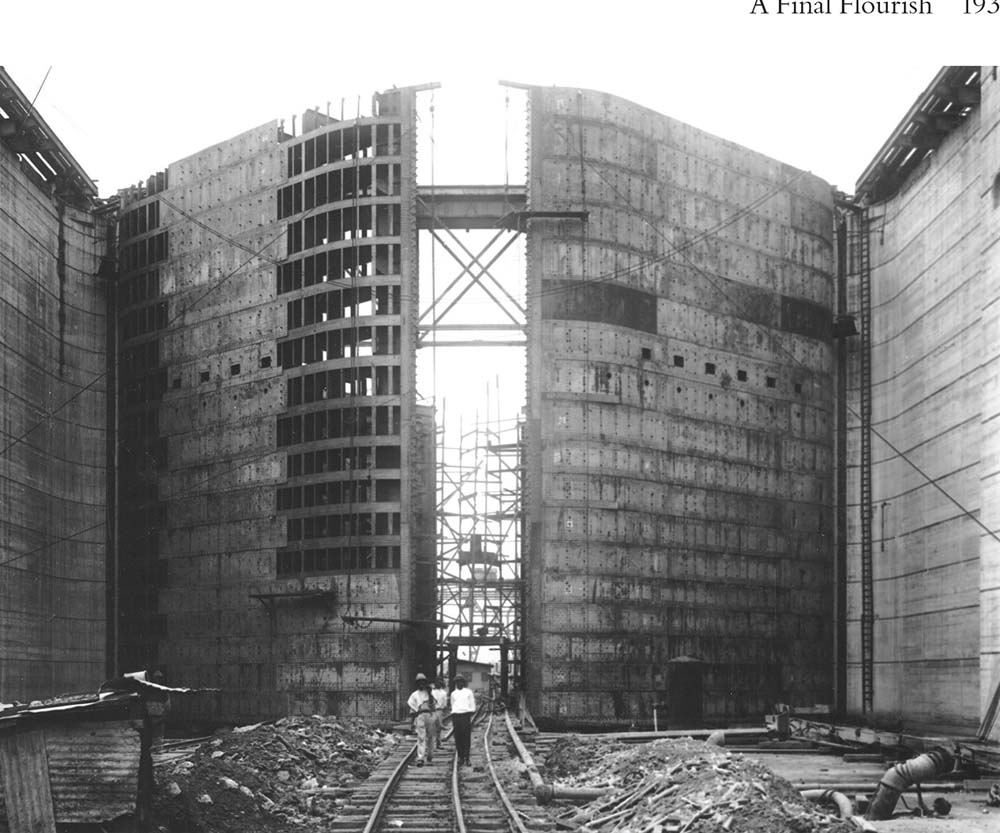
A lock under construction on the Panama Canal. The workers are dwarfed by the immense lock gates. (Library of Congress)
Stevens, who had done so much both to promote and plan the canal, resigned in 1907 on unspecified personal grounds and Roosevelt replaced him with a military man, Lieutenant Colonel George Washington Goethals. He made it clear that he was not going to run a conventional military campaign: ‘I now consider that I am commanding the Army of Panama, and that the enemy we are going to combat is the Culebra Cut and the locks and dams at both ends of the Canal, and any man who does his duty will never have any cause to complain of militarism.’ To emphasis the point, he never wore uniform while at work on the canal.
The work was finally completed in 1914 and although Goethals was the man in charge, he always gave full credit to the careful planning of his predecessor Stevens. The honours are rightly shared.
Britain also acquired a new ship canal at the end of the nineteenth century. Although it could not match either the Suez or the Panama for scale, it did also use the latest technology. The waterway was to provide a direct link from the Mersey to Manchester for vessels up to 15,000 tonnes, but allowance was made for smaller craft. Locks were duplicated: the large are 600ft by 65ft, with two pairs of intermediate gates, so that the length could be shortened; the small, relatively speaking, are 235ft by 18ft, again with intermediate gates. We know a lot about the construction, largely because this was the age when engineers produced detailed statistics. The official handbook of 1894 recorded that 76 million tonnes of spoil had been shifted, of which 20 per cent was rock; the building materials were recorded as well: 175,000 cubic yards of brick, 220,000 cubic yards of masonry and 1,250,000 cubic yards of cement.

The biggest problem facing the engineers building the Panama Canal was cutting through the hills of the continental divide at Culebra. The photograph shows SS Kentuckian being towed through the cutting, with a dredger close to the bank. (Library of Congress)
The huge mass of material removed and the extensive construction work was only possible because of technology that was not available in the earlier canal age. More than 100 steam excavators were used and some 200 cranes. Spoil was removed by wagons running on 223 miles of railway track and hauled by 173 locomotives. Yet in spite of this, the canal still relied on about 16,000 navvies. Some things may have improved over the years, but the life of the navvies had changed little. They still lived in makeshift shanty towns and did the most arduous work, such as clearing the spoil and throwing it into the high-sided trucks. In essence, it was little different from the work when digging deep cuttings for railways. The similarity to railway work was underlined by the appointment of Thomas Walker as the main contractor. He had worked on one of the most impressive engineering feats of the railway age – the building of the tunnel under the River Severn.
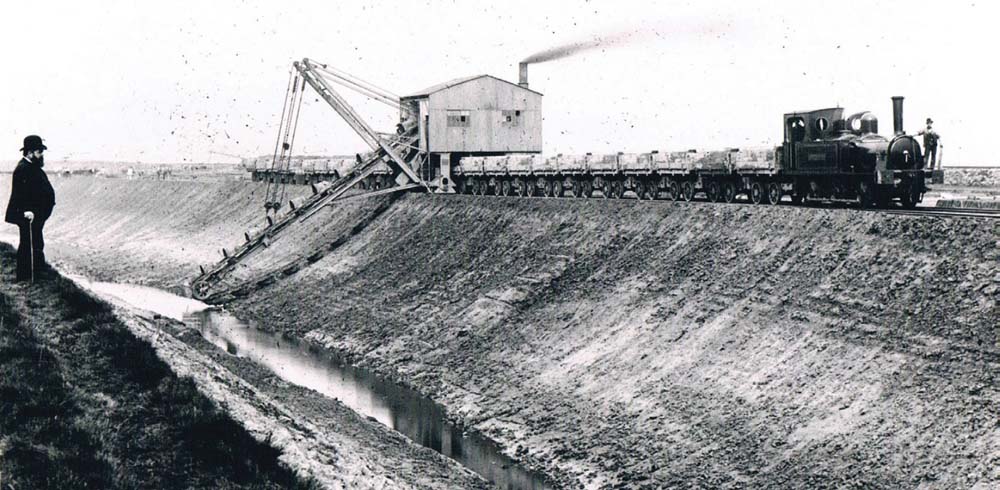
If not on the scale of the Panama Canal, the building of the Manchester Ship Canal also introduced the latest in mechanical aids, such as this mechanical steam excavator. Here too railways were laid to remove the spoil. (Waterways Archive Gloucester)
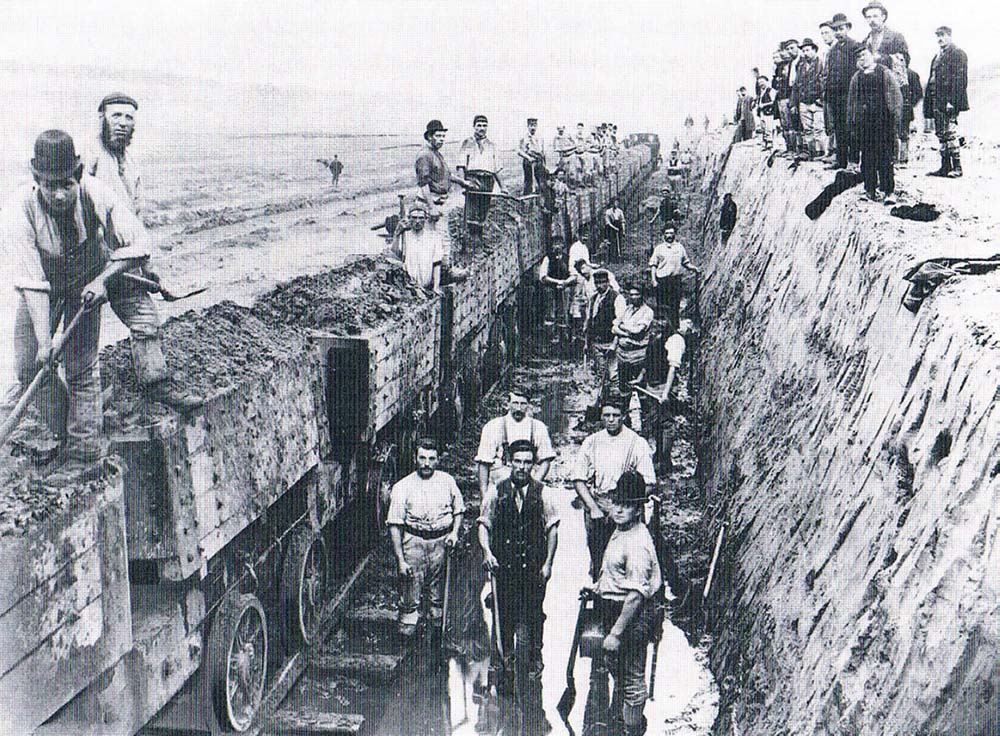
In spite of the extensive use of machines, much of the work of building the Manchester Ship canal was down to the navvies. Their job was to load spoil into the railway trucks by hand. Essentially their work was little different from what it had been when the first canals were being built more than a century earlier. (Waterways Archive Gloucester)
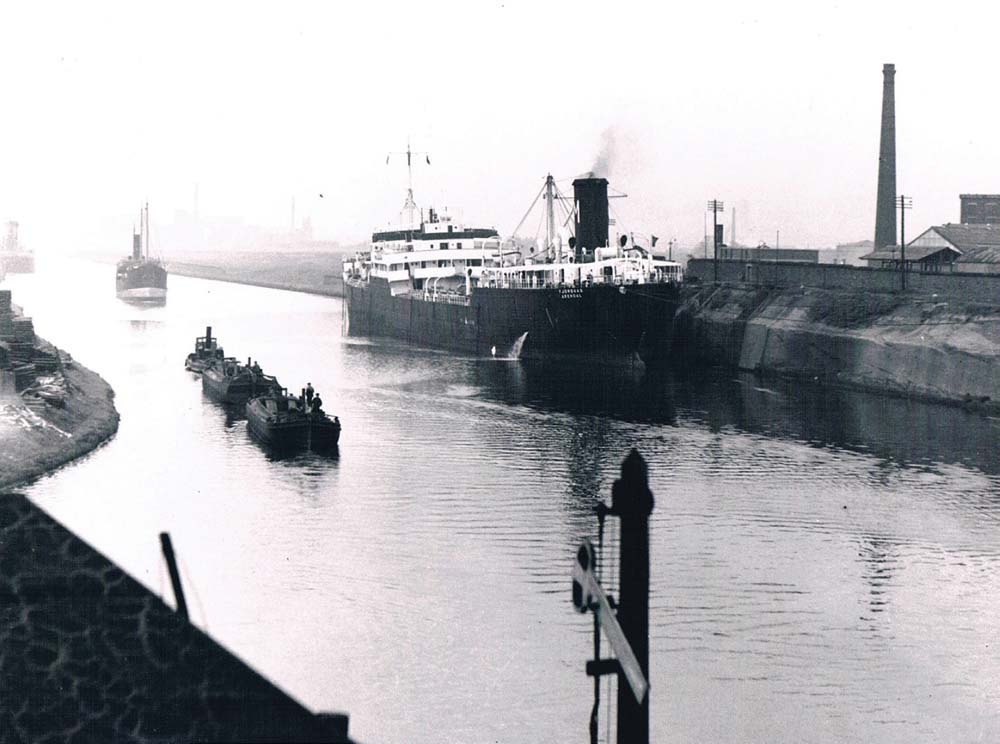
The Manchester Ship Canal in its heyday, when it was busy with traffic of all kinds, from ocean-going steamers to barges being towed by a tug. (Waterways Archive Gloucester)
The new canal cut across existing road systems, so it needed moveable bridges, worked by hydraulics. The new canal also swallowed up the old Irwell Navigation, and here there was a new problem. It was crossed by Brindley’s Barton aqueduct that was never designed to let ships pass underneath. It had to go and, instead of a swing bridge, it was replaced by a swing aqueduct. This consists of an iron trough, 18ft wide and mounted on 235ft long girders. The whole structure is carried on roller bearings, supported on a central pier. The two ends can be sealed off, so that when a ship approaches, it can be swung, full of water, through ninety degrees to align with the banks, allowing space for ships to pass either side of the central island. It is very impressive and still works beautifully: I could scarcely see a drop of water being lost from the trough.
Work on the canal began in 1887 and it opened for business in 1894. At the Manchester end, facilities were ready to accept the cargo vessels, with 200 acres of docks and 5 miles of quays. This proved attractive and a new commercial area was developed around them – Trafford Park. Many famous businesses moved in: The Co-operative Society had food warehouses and Kellogg’s made cornflakes. It became a centre for innovation and some of the leading engineering companies, including Westinghouse, also moved in.

The old and the new. In building the ship canal, the old Barton aqueduct had to be removed. This panoramic photograph shows the replacement swing aqueduct that still carries the Bridgewater Canal, with one of the many swing bridges in the background.
The Manchester Ship Canal was the last major canal undertaking completed in Britain, but it brings the story to a satisfactory conclusion. James Brindley’s Bridgewater Canal is generally seen as marking the start of the country’s enthusiasm for canals and its successor carried out the same basic function: linking the commercial heart of Manchester to the rest of the world. And Brindley would surely have been proud and amazed to find his canal swinging in mid-air. It demonstrated in dramatic fashion that the world of canals remained innovative to the end.